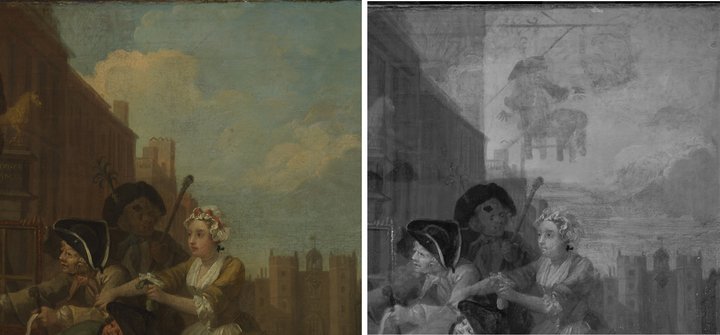A Painter’s Process
William Hogarth’s series of paintings titled A Rake’s Progress have been at Sir John Soane’s London mansion, now a delight-crammed museum, for more than two centuries.
Recently those canvases went to the Tate Britain museum for an exhibit, and while there received close scrutiny from experts at both museums and their machines. The Tate website just published an article about the findings.
It’s not surprising that Hogarth made alterations in the paintings as he went along—everything from small changes in pose to adding or removing figures. Many artists do that.
What struck me is Hogarth’s likely motivation for those changes. It wasn’t just improving the composition or storytelling, but it was also foiling copycat engravers whose work could cut into the sales of his own prints.
The article explains:
Recently those canvases went to the Tate Britain museum for an exhibit, and while there received close scrutiny from experts at both museums and their machines. The Tate website just published an article about the findings.
It’s not surprising that Hogarth made alterations in the paintings as he went along—everything from small changes in pose to adding or removing figures. Many artists do that.
What struck me is Hogarth’s likely motivation for those changes. It wasn’t just improving the composition or storytelling, but it was also foiling copycat engravers whose work could cut into the sales of his own prints.
The article explains:
Hogarth’s first advertisement of a subscription for the eight prints of A Rake’s Progress on 9 October 1733, indicated that the paintings were complete enough by this time for prospective subscribers to view them. Yet the paintings were not announced as finished until 2 November 1734:The article displays some prints derived from Hogarth’s work, not only more clumsily rendered but differing in the very details that Hogarth repainted. Evidently some competitors had gotten in to see A Rake’s Progress in progress, possibly in the guise of being potential customers, and come out with notes or sketches of the composition they saw—not knowing that the artist would make changes.
having found it necessary to introduce several additional Characters in his [Hogarth’s] Paintings of the Rake’s Progress, he could not get the Prints ready to deliver to his Subscribers at Michaelmas [Sept.29] last (as he proposed.) But all the Pictures being now entirely finished, may be seen at his House, the Golden-Head in Leicester-Fields, where Subscriptions are taken.Having engraved and published his own prints for the highly successful earlier series, A Harlot’s Progress in 1732, Hogarth was well aware of the financial advantages of eliminating the print-seller and publisher as middlemen. However, he had also suffered significant loss of income and control over quality due to the prolific plagiarism of his prints.
In response, by 1734, Hogarth had begun ‘An Act for the encouragement of the arts of designing, engraving, and etching historical and other prints, by vesting the properties thereof in the inventors and engravers’, petitioning parliament to support legal ownership and profit for an artists’ own work. Although Hogarth may have initially delayed the print publication due to compositional changes to his paintings, the several months of delays that followed were likely an attempt to negate the piracy, yet again, of his work by copyists.
In a final delay announced on 10 May 1735, Hogarth is explicit about the reasons for postponing the print distribution to subscribers:N.B. Mr. Hogarth was, and is oblig’d to defer the Publication and Delivery of the abovesaid Prints till the 25th June next, in order to secure his Property, pursuant to an Act lately passed both Houses of Parliament, now awaiting for the Royal Assent, to secure all new invented Prints that shall be published after the 24th of June next, from being copied without Consent of the Proprietor, and thereby preventing a scandalous and unjust Custom (hitherto practiced with Impunity) of making and vending base Copies of original Prints, to the manifest Discouragement of the Arts of Paintings and Engraving.Hogarth finally released the prints for A Rake’s Progress on 25 June 1735, as the Copyright Act came into force.


No comments:
Post a Comment